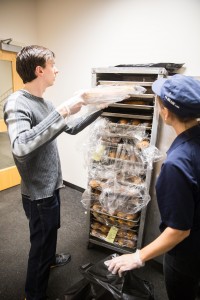Service is good for the soul. For some students it is good for their grades, too.
Robert Freeman requires his students to complete four hours of community service during the length of the semester with the hope it will change lives.

Freeman has taught at BYU for nearly 20 years and is associate dean of religious education. He urged students to serve in years past, but this is the first semester it is a graded requirement.
“The requirement that I provide for my students is that they give a number of hours of service through the semester and that it’s not as an extension of their ward callings or family affiliations but that this is different,” Freeman said. “This is service that is community-based and that gets them out interacting, typically with strangers.”
Freeman was told by one of the university administrators that community-based service from BYU students was lacking. He took that as a signal to introduce students in his Teachings of the Living Prophets class to more service experiences.
“This is a natural fit because our current president, Thomas S. Monson — that’s the theme of his administration, the theme of his ministry,” Freeman said.
Some professors already include service in class, but Freeman wanted it to be a part of his class as well.
Freeman guides his students toward the campus’s service hub, Y-Serve, but also encourages students serving in other projects to continue. Freeman considers this requirement “a great opportunity to commend” and awards students who are already serving in the community.
“We become so preoccupied with our studies and our work and such, we just check the box that because I have a calling in my ward or family occupations that I’ve got it covered,” Freeman said.
However, there is a large community around BYU that needs the creativity and talents BYU students possess.
Caleb Brown, a senior from Chicago studying food industry management, uses surplus bread from the Blue Line Deli & Market on campus to donate to organizations such as Tabitha’s Way or the Seventh-day Adventist Church. His service fulfills Freeman’s class requirement.
Brown happened to come upon the cafe while looking for an event and noticed the large amount of bread going to waste.
“I know that people are in need of it and I just really don’t like food going to waste,” Brown said. “We are in a very blessed land and a very blessed area. There are still those around us that are hungry and that could use that.”
Brown performed a similar service in Chicago after noticing a comparable loss of food at the Panera Bread where he worked. Some of the items were donated, but the cut bread used for sandwiches and other menu items was thrown out. Once Brown realized how much food was regularly discarded, he cleared it with his managers to make charitable donations from there on out.
Incorporating service inspires students to spread light and goodness, but for some students and recipients of that service, it can be life-changing.
“In a couple of circumstances or situations, the way the student reported their service convinced me that literally a life might have been preserved through their generous sharing of their time and talent,” Freeman said. “It’s given me a whole new perspective on the notion of ‘Enter to learn, go forth to serve.'”
Trevor Lillywhite, a junior in chemical engineering from New Mexico, said she was tremendously affected by the inclusion of service in class. His experience started while he was in a foundations of global leadership class with Ron Terry, Ph.D.
“The first time around, I wasn’t very fond of the idea,” Lillywhite explained. “I simply didn’t want to do it.”

A friend in the class introduced Lillywhite to a program called Brighter Horizons, where students mentor and serve alongside teenagers who are in correctional or state facilities. After Lillywhite completed the requirement of service, he continued to go back to volunteer.
One year after that, Lillywhite was again told to complete service for a class grade. He began to get involved in Habitat for Humanity, building homes for those in need.
“I went back several times that semester and it carried on into the following semester,” Lillywhite said, “Eventually, I became one of the program directors over Habitat, and now I’ve participated in dozens of builds and dedicated hundreds of hours to Y-Serve.”
Others of Freeman’s students served with the Assisted Care Center, Pediatric Center, Adaptive Aquatics, Horses for Healing and a variety of other charitable organizations.
“I’m indebted to those professors who gave me a little push to get involved in meaningful service and also to everyone who has made these experiences possible,” Lillywhite said. “BYU has an incredible culture of service, and I just hope that students are aware of the possibilities to get involved.”
Many students find impacting experiences similar to Brown’s and Lillywhite’s with these organizations and other events through Y-Serve.
“Every time I participate in a service activity, I have a great time and I know there’s no better way I could have spent my time,” said BYU junior Alex Dahl.
Going forth to serve may mean getting an occupation and having a career, but it can also mean serving others.
“Much of it will be done in church service. Much of it will be done in family service,” Freeman said. “There is a crying need in the world to provide that service to our communities.”




